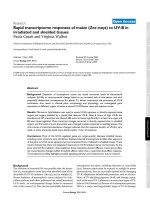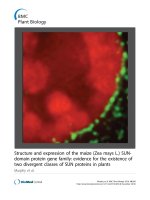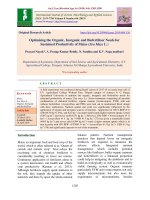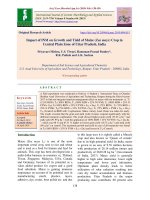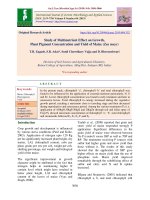Studies on FYM and vermi-compost on soil health and economics profitability of organic fertilizer of maize (Zea mays L.)
Bạn đang xem bản rút gọn của tài liệu. Xem và tải ngay bản đầy đủ của tài liệu tại đây (159.88 KB, 4 trang )
��������������������������������������������������������������������������������������������������������������������������������������������������������������������������������������������������������������������������������������������������������������������������������������������������������������������������������������������������������������������������������������������������������������������������������������������������������������������������������������������������������������������������������������������������������������������������������������������������������������������������������������������������������������������������������������������������������������������������������������������������������������������������������������������������������������������������������������������������������������������������������������������������������������������������������������������������������������������������������������������������������������������������������������������������������������������������������������������������������������������������������������������������������������������������������������������������������������������������������������������������������������������������������������������������������������������������������������������������������������������������������������������������������������������������������������������������������������������������������������������������������������������������������������������������������������������������������������������������������������������������������������������������������������������������������������������������������������������������������������������������������������������������������������������������������������������������������������������������������������������������������������������������������������������������������������������������������������������������������������������������������������������������������������������������������������������������������������������������������������������������������������������������������������������������������������������������������������������������������������������������������������������������������������������������������������������������������������������������������������������������������������������������������������������������������������������������������������������������������������������������������������������������������������������������������������������������������������������������������������������������������������������������������������������������������������������������������������������������������������������������������������������������������������������������������������������������������������������������������������������������������������������������������������������������������������������������������������������������������������������������������������������������������������������������������������������������������������������������������������������������������������������������������������������������������������������������������������������������������������������������������������������������������������������������������������������������������������������������������������������������������������������������������������������������������������������������������������������������������������������������������������������������������������������������������������������������������������������������������������������������������������������������������������������������������������������������������������������������������������������������������������������������������������������������������������������������������������������������������������������������������������������������������������������������������������������������������������������������������������������������������������������������������������������������������������������������������������������������������������������������������������������������������������������������������������������������������������������������������������������������������������������������������������������������������������������������������������������������������������������������������������������������������������������������������������������������������������������������������������������������������������������������������������������������������������������������������������������������������������������������������������������������������������������������������������������������������������������������������������������������������������������������������������������������������������������������������������������������������������������������������������������������������������������������������������������������������������������������������������������������������������������������������������������������������������������������������������������������������������������������������������������������������������������������������������������������������������������������������������������������������������������������������������������������������������������������������������������������������������������������������������������������������������������������������������������������������������������������������������������������������������������������������������������������������������������������������������������������������������������������������������������������������������������������������������������������������������������������������������������������������������������������������������������������������������������������������������������������������������������������������������������������������������������������������������������������������������������������������������������������������������������������������������������������������������������������������������������������������������������������������������������������������������������������������������������������������������������������������������������������������������������������������������������������������������������������������������������������������������������������������������������������������������������������������������������������������������������������������������������������������������������������������������������������������������������������������������������������������������������������������������������������������������������������������������������������������������������������������������������������������������������������������������������������������������������������������������������������������������������������������������������������������������������������������������������������������������������������������������������������������������������������������������������������������������������������������������������������������������������������������������������������������������������������������������������������������������������������������������������������������������������������������������������������������������������������������������������������������������������������������������������������������������������������������������������������������������������������������������������������������������������������������������������������������������������������������������������������������������������������������������������������������������������������������������������������������������������������������������������������������������������������������������������������������������������������������������������������������������������������������������������������������������������������������������������������������������������������������������������������������������������������������������������������������������������������������������������������������������������������������������������������������������������������������������������������������������������������������������������������������������������������������������������������������������������������������������������������������������������������������������������������������������������������������������������������������������������������������������������������������������������������������atments. Highest input cost
was recorded for treatments T4 followed by
T3. Benefit cost ratio (B:C ratio) was also
calculated and presented in Table 1 and 2.
B:C ratio was highest for T8 followed by T4.
Treatment T8 is superior for Vermi-compost
application and T4 was superior for FYM
treatment. These two treatments were
significantly differs from other treatments
based on CD value for yield per plot. B:C
ratio was also higher for these two treatments
which showed that per unit input for these
two treatment can return lot of output.
Table.1 Effect of different doses of FYM and Vermi-compost on soil health
Sl. No.
1.
2.
3.
4.
5.
6.
7.
8.
9.
Treatment
No.
T0
T1
T2
T3
T4
T5
T6
T7
T8
Treatment
0% (control)
25% (F.Y.M.)
50% (F.Y.M.)
75% (F.Y.M.)
100% (F.Y.M.)
25% (Vermi-compost)
50% (Vermi-compost)
75% (Vermi-compost)
100% (Vermi-compost)
2040
Grain
Yield
2.42
3.23
3.91
4.10
4.83
2.84
3.70
4.13
4.98
Int.J.Curr.Microbiol.App.Sci (2020) 9(5): 2038-2041
Table.2 Economics of the opted treatments for Maize crop
Treatment
T0
T1
T2
T3
T4
T5
T6
T7
T8
Yield
(q/ha)
16.14
21.54
26.07
27.34
32.2
18.94
24.67
27.54
33.2
Yield
(kg/ha)
16140
21540
26070
27340
32200
18940
24670
27540
33200
Rate of
maize seeds
120.00/kg
120.00/kg
120.00/kg
120.00/kg
120.00/kg
120.00/kg
120.00/kg
120.00/kg
120.00/kg
Therefore it can be concluded that Treatment T8
and T4 were overall best performing treatments
for maize crop. Economics of all the treatments
showed that control treatment has lowest output
as compare to other treatment. Highest output
was recorded by treatment T8 followed by T4.
Lowest input cost was taken by T5 followed by
T6 but output of these two treatments was lower
than the control treatment (Golada et al., 2013).
Benefit Cost ratio was highest for T8 followed
by T4. Treatment T8 is superior for Vermicompost application and T4 was superior for
FYM treatment. These two treatments were
significantly differs from other treatments based
on CD value for yield per plot. B: C ratio was
also higher for these two treatments which
showed that per unit input for these two
treatments can return lot of output (Arvadiya et
al., 2017).
References
Arvadiya, L. K., Raj, V. C., Patel, T. U. and
Total output
(Rs.)
1936800
2584800
3128400
3280800
3864000
2272800
2960400
3304800
3984000
Input cost
(Rs.)
8340
8236
8452
8668
8884
8127
8236
8344
8451
B:C ratio
232.23
313.84
370.14
378.50
434.94
279.66
359.45
396.07
471.42
Arvadiya, M. K. (2017). Effect of F.Y.M.
and Vermi-compost on yield and
associated in analysis of maize (Zea mays
L.). Indian Journal of Agronomy, 57(2):
62-67.
DMR
(2016).
“Maize
Biology:
An
Introduction”. Directorate of Maize
Research, ICAR, New Delhi.
Golada, S. L., Sharma, G. L. and Jain, H. K.
(2013). Effect of organic manures and
inorganic fertilizers on growth and yield
in maize under sub humid condition in
Rajasthan, India. African Journal of
Agricultural Research, 8(12): 1100-1107.
Gollar, R. G. and Patil, V. C. (2016). Effect of
organic manures and inorganic fertilizers
on yield and quality of maize. Journal of
Plant Science, 13(1): 1-6.
Verma, A. and Tomar, G. S. (2017). Effect of
F.Y.M. and Vermi-compost different
levels on grain yield and quality of maize
(Zea may saccharata Sturt.) Journal of
Agriculture Issues, 18(1-2): 31-33.
How to cite this article:
Ravindra Kumar, Uday Kumar, Nishchal Chandrakar and Rajiv Kumar. 2020. Studies on FYM and
Vermi-Compost on Soil Health and Economics Profitability of Organic Fertilizer of Maize (Zea
mays L.). Int.J.Curr.Microbiol.App.Sci. 9(05): 2038-2041.
doi: />
2041

